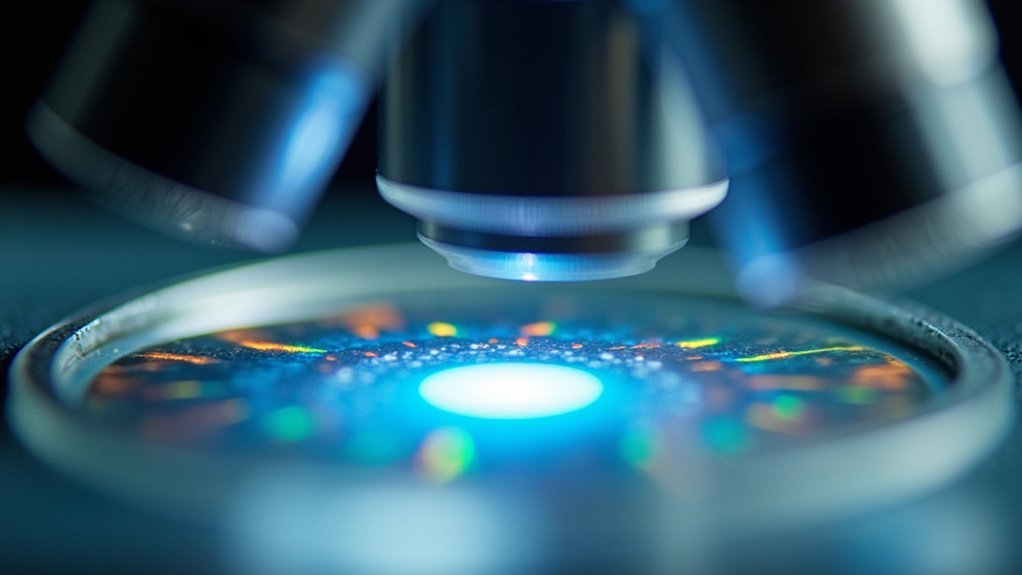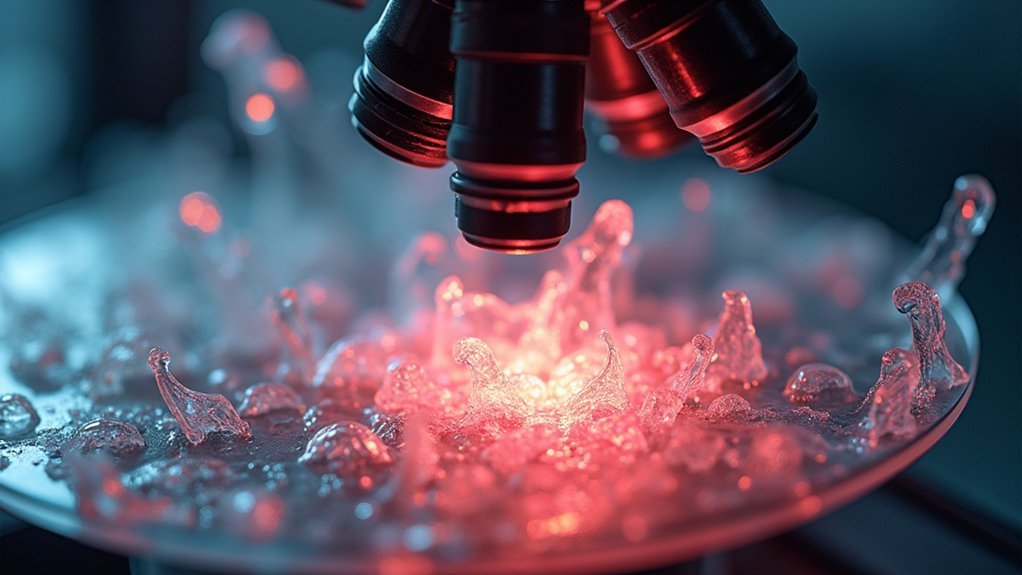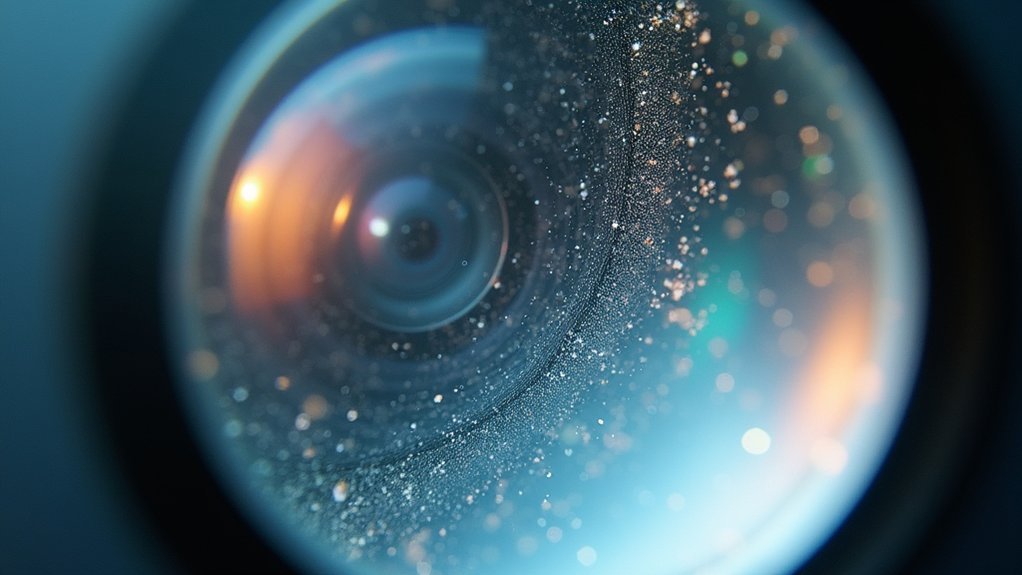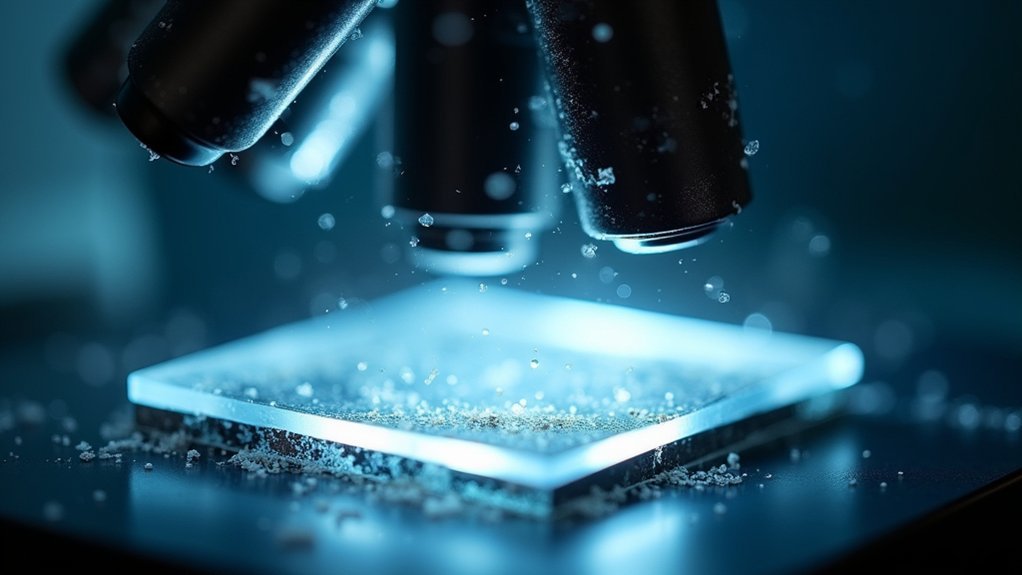Blurry phase contrast images typically result from misaligned phase rings or annular diaphragms, incorrect condenser positioning, inappropriate light intensity, or contaminated optical components. Your specimen preparation might also be causing issues if it’s too thick or contains air bubbles. Check your objective lens selection to guarantee proper numerical aperture and compatibility. Environmental factors like vibrations and temperature fluctuations can further degrade image quality. Proper maintenance and alignment of your microscope components will dramatically improve your results.
Misalignment of Phase Rings and Annular Diaphragm

When working with phase contrast microscopy, misalignment of phase rings and the annular diaphragm is often the primary culprit behind blurry images.
If your phase rings aren’t properly aligned, they can’t perform the phase shifting correctly, resulting in diminished contrast and detail in your specimens.
You’ll notice uneven illumination when your annular diaphragm isn’t positioned to match the objective’s phase ring.
Proper alignment between annular diaphragm and phase ring is crucial—mismatches create uneven illumination and compromise specimen clarity.
This misalignment causes phase contrast to vary across your field of view, leading to inconsistent sharpness in different areas of the specimen.
To maintain peak image quality, regularly check that both components are properly centered.
Also verify your annular diaphragm is set to the correct aperture size—improper settings impair the phase rings’ effectiveness and reduce resolution in your microscopy work.
Incorrect Condenser Height and Positioning
Beyond alignment issues with phase rings, proper condenser height and positioning directly impact your phase contrast image quality.
As any Microscopy U expert will tell you, condenser adjustments are fundamental to successful microscopy.
When your condenser isn’t properly positioned, expect these problems:
- Inadequate focus – Light rays won’t converge correctly, creating blurry images lacking fine detail.
- Reduced light intensity – Positioning too far from specimens causes significant contrast loss.
- Disrupted phase shifting – Improper height prevents suitable phase differences needed for contrast.
- Distracting artifacts – Misalignment introduces optical distortions that compromise image integrity.
Regular condenser adjustment is essential in quality phase contrast microscopy.
The source for microscopy education emphasizes that proper condenser height refinement should be part of your routine setup before every critical imaging session.
Inappropriate Light Source Intensity and Quality

Incorrect light intensity will disrupt your phase contrast imaging by washing out details at high levels or obscuring transparent structures at low levels.
You’ll notice uneven illumination causing inconsistent contrast across your specimen, making fine cellular structures difficult to differentiate.
When your light source quality is poor, halation effects can form around specimen edges, creating bright halos that blur boundaries and diminish the resolution of critical features.
Light Intensity Disrupts Contrast
Although often overlooked, the intensity and quality of your light source play a crucial role in phase contrast microscopy. When improperly adjusted, light intensity can dramatically affect your image clarity and contrast.
- Too little light leads to insufficient contrast, making it difficult to distinguish fine details in your specimens as phase differences become indiscernible.
- Excessive brightness creates glare and overexposure, washing out the contrast that’s necessary for phase contrast imaging.
- Light source quality affects phase shifts that enhance contrast—unstable or poorly aligned sources compromise image clarity.
- Different specimens require specific illumination levels for ideal visualization.
Regular maintenance and calibration of your light source guarantees consistent intensity and quality, preventing the blurriness that can plague your phase contrast images.
Uneven Illumination Issues
When your phase contrast microscope produces blurry images, the culprit often lies in uneven illumination across your field of view. This typically results from inappropriate light source intensity—some areas appear overexposed while others remain underexposed, compromising clarity.
Your light source’s quality is equally critical. Bulbs emitting inconsistent wavelengths create artifacts and diminish image quality. Too much intensity causes glare and detail loss, while insufficient light leads to inadequate contrast and blurriness.
You’ll need to regularly calibrate and maintain your light source to guarantee even illumination, essential for clear imaging. Use your microscope’s built-in controls to adjust intensity for ideal results.
This simple adjustment can dramatically enhance transparent specimens’ visibility without sacrificing important details.
Halation Effect Formation
Beyond uneven illumination lies a more specific image quality challenge: the halation effect. This phenomenon occurs when your light source overwhelms the phase contrast optics, causing light to scatter excessively around specimen edges.
To understand how halation forms in your microscopy setup:
- Excessive intensity – When your light source is too bright, it overwhelms the phase rings, creating a hazy glow that obscures fine details.
- Wavelength issues – Broad-spectrum light sources produce chromatic aberrations that contribute to blurriness.
- Poor calibration – Uncalibrated light sources deliver inconsistent illumination, degrading image quality.
- Lack of maintenance – Neglected light components gradually lose ideal performance.
You can mitigate halation by reducing light intensity and ensuring regular maintenance of your illumination system, resulting in sharper, more detailed phase contrast images.
Contaminated Optical Components and Surfaces

You’ll find that oil smudges on optical components greatly distort phase contrast by altering light diffraction patterns and reducing overall image clarity.
Dust particles settling on lenses or phase rings degrade the light path, creating unwanted diffraction that manifests as hazy images with poor resolution.
Even microscopic growths on optical surfaces can introduce unexpected artifacts, as bacterial or fungal contamination changes the refractive properties of components and produces misleading contrast variations in your specimens.
Oil Smudges Distort Contrast
The invisible culprits behind many blurry phase contrast images are oil smudges on optical components.
When these greasy deposits contaminate your microscope’s lenses or phase rings, they scatter light in unpredictable ways, undermining the precise refractive index differences that make phase contrast microscopy effective.
These contaminants impact your imaging in four critical ways:
- Light scattering that reduces overall image clarity
- Interference with the phase contrast mechanism, distorting results
- Creation of artifacts that can obscure fine cellular details
- Reduction in the high contrast levels needed for proper visualization
Even trace amounts of oil can greatly degrade your results.
Regular cleaning with appropriate solvents is essential to maintain peak performance and prevent these invisible enemies from compromising your observations of live specimens.
Dust Degrades Light Path
While oil smudges disrupt contrast through refractive interference, dust particles present an equally formidable obstacle to clear phase contrast imaging.
Even microscopic debris on lenses and phase rings can scatter light, greatly reducing image clarity and resolution.
When dust accumulates on your microscope’s optical components, it creates unwanted artifacts that obscure the fine details of transparent specimens.
The contaminated surfaces interfere with the precise light path required for phase contrast, resulting in blurry, lower-quality images.
Your condenser is particularly vulnerable—dust here disrupts the even distribution of light that’s essential for effective phase contrast.
To maintain ideal performance and image sharpness, you’ll need to regularly clean all optical surfaces.
Remember that even particles invisible to the naked eye can considerably impact your imaging quality.
Microbial Growth Effects
Beyond dust and oil contamination, microbial growth on optical surfaces creates an insidious threat to phase contrast image quality.
Microscopes in humid environments are particularly vulnerable to biofilm formation that progressively degrades imaging performance.
These microbial contaminants affect your imaging through:
- Light scattering from bacterial and fungal colonies on lenses and mirrors, creating diffuse blurring across your field of view
- Biofilm formation that coats optical surfaces, obscuring light paths and reducing specimen clarity
- Interference patterns from surface contaminants that disrupt the phase contrast effect
- Specimen obstruction when microbes colonize slides and coverslips, making accurate focusing nearly impossible
Regular disinfection of all optical components is essential, not just for equipment longevity but for maintaining the resolution and contrast required for precise phase contrast microscopy.
Improper Specimen Preparation Techniques

Five critical preparation errors frequently sabotage phase contrast imaging quality.
If you’re creating specimens that are too thick, you’re effectively blocking light transmission, resulting in blurry images with poor contrast.
Air bubbles or debris on your slides disrupt the light path, causing visual distortions that compromise image integrity.
When you neglect proper fixation or staining protocols, you create uneven refractive indices throughout your specimen, resulting in inconsistent contrast and reduced clarity.
Failing to center specimens in your field of view leads to out-of-focus areas that appear blurry regardless of your focusing efforts.
Finally, your choice of mounting media matters greatly—inappropriate options alter the refractive index relationship between your specimen and surroundings, undermining the phase contrast mechanism and producing suboptimal images with reduced sharpness.
Objective Lens Selection and Matching Errors
Even perfectly prepared specimens will appear blurry if you’ve selected inappropriate objective lenses.
Phase contrast microscopy demands proper lens selection and alignment to achieve crisp, detailed images.
When troubleshooting blurry phase contrast images, consider these four critical factors:
- Numerical Aperture (NA) – Using an objective with incorrect NA reduces light gathering ability, producing fuzzy images.
- Phase Ring Matching – Misaligned phase rings between the objective and condenser prevent proper phase contrast effect.
- Condenser Settings – Objective-condenser mismatch leads to poor alignment and decreased image sharpness.
- Lens Cleanliness – Dust or debris on objectives scatters light and degrades image quality.
Remember that phase contrast microscopy requires specialized objectives designed specifically for this technique—standard brightfield objectives won’t reveal transparent specimens with the same clarity.
Environmental Factors Affecting Image Stability

While optical components and technique are essential, environmental conditions often undermine your phase contrast imaging without you realizing it. Vibrations from nearby equipment or foot traffic can greatly blur images by disrupting microscope stability.
Environmental factors silently sabotage phase contrast imaging while you focus solely on equipment and methodology.
You’ll find temperature fluctuations cause thermal drift in optical components, leading to misalignment and reduced clarity over time. High humidity introduces condensation on optical surfaces, scattering light and diminishing contrast.
Even air currents from windows or HVAC systems can disturb fine focus adjustments, resulting in blurry images.
Don’t overlook dust and particulate matter—these settle on optical elements, causing light scattering and resolution loss.
To achieve ideal phase contrast imaging, you must control these environmental variables as carefully as you select your equipment.
Frequently Asked Questions
How Do You Get a Good Image Under Phase Contrast Microscope?
To get a good phase contrast image, you’ll need to use the correct objective lens, adjust condenser height properly, align phase rings with a centering telescope, and fine-tune light intensity for maximum clarity.
What Might Be the Reasons for Blurry or Distorted Images When Using a Microscope?
Your microscope might produce blurry images due to dirty lenses, improper alignment of optical components, insufficient light, misaligned phase rings, or lack of regular calibration and maintenance of your optical system.
What Are the Limitations of Phase Contrast?
Phase contrast limitations include halo artifacts, struggles with minimal refractive index variation, sensitivity to misalignment, unsuitability for thick specimens, and dependence on proper illumination. You’ll need alternative techniques for these challenging situations.
What Can We Determine From This Phase Contrast Image of a Cell?
You can determine the cell’s internal structures, metabolic state, density variations, specific cell type, and intercellular interactions from this phase contrast image. It also reveals membrane integrity and overall cellular health.
In Summary
You’ll find most blurry phase contrast images stem from technical misalignments between phase rings and annular diaphragms, improper condenser positioning, or inadequate light adjustment. Don’t overlook dirty optical surfaces, poor specimen preparation, or mismatched objectives. By methodically troubleshooting these elements and controlling environmental factors like vibrations, you’ll dramatically improve image clarity and achieve the crisp contrast that makes this technique so valuable.





Leave a Reply